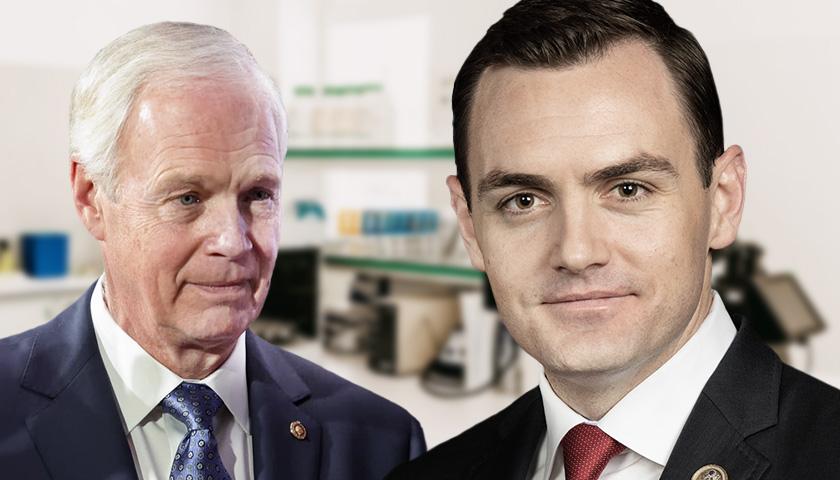Wisconsin’s Republican congressional delegation wants answers from federal health agencies following recent revelations of a biosafety lab incident at the University of Wisconsin-Madison.
The so-called gain-of-function experiments at Wisconsin’s flagship public university shine a brighter light on the same scientific practices used in a lab in Wuhan, China, that are suspected of unleashing the COVID-19 pandemic on the world.
“The report of these two researchers’ potential exposure to a genetically engineered virus and alleged failures to adequately address said exposures raises questions about HHS’s oversight of biosafety incidents,” states a letter from the delegation to Health and Human Services Secretary Xavier Becerra, Centers of Disease Control and Prevention Director Rochelle Walensky and Dr. Lawrence A. Tabak, acting director of the National Institutes of Health.
A recent USA Today opinion piece, adapted from investigative reporter Alison Young’s forthcoming book, reveals for the first time details of a December 2019 lab safety breach involving “one of the world’s most infamous lab-created ‘gain of function’ viruses.” The book Pandora’s Gamble: Lab Leaks, Pandemics, and a World at Risk also describes the efforts made to downplay the troubling event, the failure of officials to notify health authorities and oversight bodies, and to generally keep the public and policymakers in the dark.
“The incident, which potentially exposed individuals to a genetically engineered virus, raises serious questions about the requirements that the HHS, NIH, and CDC have in place and the basic processes for oversight and transparency at labs that engaged in risky gain-of-function research,” said U.S. Representative Mike Gallagher (R-WI-08), who led the congressional delegation in the letter to the health officials.
In 2019 scientists at the UW’s “high-security” Influenza Research Institute were working with “one of two infamous lab-made bird flu viruses that had alarmed scientists around the world when their creation became widely known nearly a decade earlier.” It was a manipulation game. Scientists took the virus that proved deadly to birds and, using gain-of-function processes, manipulated it in ways that could raise its threat in humans, Young explains in her book, released on Tuesday.
“The virus they were working with that day was far from ordinary, and there should have been no room for the safety breach that was about to happen and the oversight failures that followed,” Young wrote.
During sample collections from infected ferrets, the researchers realized that the respirator hose providing safe air to a trainee had disconnected, potentially exposing the individual to the virus.
In November 2013, according to the investigative reporter, a researcher “accidentally pierced their finger” with a needle contaminated with the virus. The CDC considered it a “serious exposure” and UW-Madison lab officials directed the researcher to quarantine for a week at home, the lawmakers wrote in the letter.
According to the piece, the director of the experiments, virologist Dr. Yoshihiro Kawaoka “assured officials at NIH that the university had a designated quarantine apartment.” The column suggests that NIH subsequently learned the university did not have a dedicated quarantine facility.
The university issued a statement claiming the column “broadly and harmfully asserts wrongdoing on the part of the University of Wisconsin–Madison that is not rooted in the facts, including those provided to her by the university and in public documents in her possession.”
“The outcome is a story that irresponsibly sensationalizes a topic of immense public concern in the wake of the COVID-19 pandemic,” Steve Ackerman, vice chancellor for Research and Graduate Education, said in a response sent to The Wisconsin Daily Star. “It targets a lab with a stellar safety record and history of strong accountability, and it seeks to undermine critical research performed for societal benefit, including the development of drugs and treatments for some of the world’s most intractable infectious diseases.”
UW-Madison doesn’t deny the biosafety incidents took place. But, among other points of dispute, Ackerman claims that the university shared the 2013 incident with federal agencies and followed its protocols for managing a low-risk exposure. He called the hose disconnection in 2019 a ‘momentary” event in which “the infectious agent was stored away, infected animals were in HEPA-filtered containment cages, the biosafety cabinet where the sample collection took place had been disinfected and Tyvek sleeves and outer gloves had been disinfected and changed. The detachment was also so brief that the researcher would have continued to breathe the filtered air still present in their PAPR [powered air purifying respirator].”
But the revelations about the biosafety incidents at the UW-Madison lab raise more troubling questions about the dangers of gain-of-function experiments that, as U.S. Senator Rand Paul (R-KY) put it, juice up naturally occurring animal viruses in a lab to make them more infectious among humans.
Scientists like Kawaoka have argued the experiments are critical to learning about and combatting infectious diseases, particularly the deadliest viruses. In fact, Kawaoka has said it would be “irresponsible not to study” how viruses might evolve in nature.
“Some people have argued that the risks of such studies – misuse and accidental release, for example – outweigh the benefits. I counter that H5N1 viruses circulating in nature already pose a threat,” he said at the time, according to the USA Today column.
But it appears increasingly likely that one of the deadliest viruses known to man was created in and escaped from a China-based lab — or labs.
A report issued last week by U.S. Senator Roger Marshall (R-KS.) suggests millions of lives lost to COVID-19 could have been saved if not for a “coverup” by the Chinese government.
“This report concludes most likely this was two leaks [including] a lab leak in the September-October [2019] timeframe, even as early as July or August,” the medical doctor turned senator told the New York Post ahead of the release of the 301-page document.
“We’ve concluded that [China] started vaccine development in November 2019. And then another lab leak seems to be the most sensible explanation,” he said. “There are key data points that are being held back that could help us prove that.”
Dr. Robert Kadlec, a cofounder of the Operation Warp Speed program that rapidly developed U.S. COVID-19 vaccines in 2020, drafted the report titled “Muddy Waters: The Origins of COVID-19” with about a dozen Republican aides on the Senate Health Committee and additional outside consultants.
Gallagher and his Wisconsin Republican congressional colleagues, including U.S. Senator Ron Johnson, say they want to better understand how the Department of Health and Human Services handles biosafety incidents at U.S. research institutions like U.W. Madison. In their letter to the federal health officials they request:
- A complete list of all biosafety incidents reported to HHS from January 1, 2013 to present, including a description of the type of incident that occurred, the date that said incident occurred, the institution where said incident occurred, and whether said incident led to infection.
- A copy of any reports submitted to HHS regarding the two biosafety incidents in Dr. Kawaoka’s lab that occurred in November 2013 and December 2019.
- For any research institution receiving HHS funds, a description of: a) The obligations to report actual or potential exposure to an infectious agent; b) The obligations to report actual or potential exposure to an infectious agent subject to either the 2014 moratorium on gain-of-function research; and c) The obligations to report actual or potential exposure to an Enhanced Potential Pandemic Pathogen;
- Does HHS require institutions to notify local and/or state health officials when an actual or potential exposure occurs? If so, please describe what notification is required.
- Does HHS provide guidance on what qualifies as an exposure, potential exposure, or non-exposure in the event of a biosafety incident? If so, please provide copies of said guidance.
- How often does HHS conduct inspections or audits of research facilities working with infectious agents? Please provide a list of each institution inspected or audited, including the date the most recent inspection or audit occurred and the rating or outcome of said audit or inspection.
The lawmakers have requested a response by no later than May 19.
– – –
M.D. Kittle is the National Political Editor for The Star News Network.
Photo “Mike Gallagher” by U.S. House Office of Photography. Photo “Ron Johnson” by Senator Ron Johnson. Background Photo “Science Lab” by Trnava University.






The people who make a living off government funding are not about to cut off that funding by being honest. If you give them more money the will conduct a study to see if there is any reason not to give them more money.